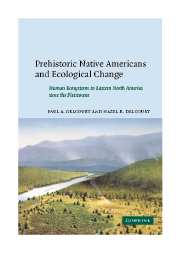 Prehistoric Native Americans and Ecological Change
Prehistoric Native Americans and Ecological Change PART I - PANARCHY AS AN INTEGRATIVE PARADIGM
Published online by Cambridge University Press: 30 October 2009
Summary
OVERVIEW
Whether or not prehistoric Native Americans were a significant ecological factor has been the subject of intense debate among generations of ecologists. During the latter half of the twentieth century, the pendulum of opinion has swung from the belief that American Indians had no influence on the composition and structure of plant and animal communities to the assertion that they were responsible for destruction of native habitats through over-exploitation of natural resources and widespread use of fire.
Quaternary paleoecology and archaeology are inherently multidisciplinary fields, drawing upon proxy information from data sets representing past states of climate, soils and geomorphology, biota, and material culture to make interpretations of changes in natural and cultural landscapes over millennial time scales. Time series of paleoecological and archaeological data yield chronologies of changes in both ecosystems and social systems. Before 1980, however, relatively few studies combined archaeological and paleoecological methods to determine objectively the kinds, extent, and duration of ecological influences by prehistoric Native Americans. Although a number of exemplary studies have been conducted since that time, the challenge remains to integrate available information effectively from paleoecology and archaeology in order to understand the linkages and dynamic feedbacks of processes underlying the documented patterns of change in prehistoric human ecosystems.
Panarchy theory has been developed recently by C.S. Holling and colleagues (Gunderson and Holling, 2001; Holling 2001) as an extension of hierarchy theory that includes cycles of adaptation in ecological and cultural processes.
- Type
- Chapter
- Information
- Prehistoric Native Americans and Ecological ChangeHuman Ecosystems in Eastern North America since the Pleistocene, pp. 1 - 2Publisher: Cambridge University PressPrint publication year: 2004


